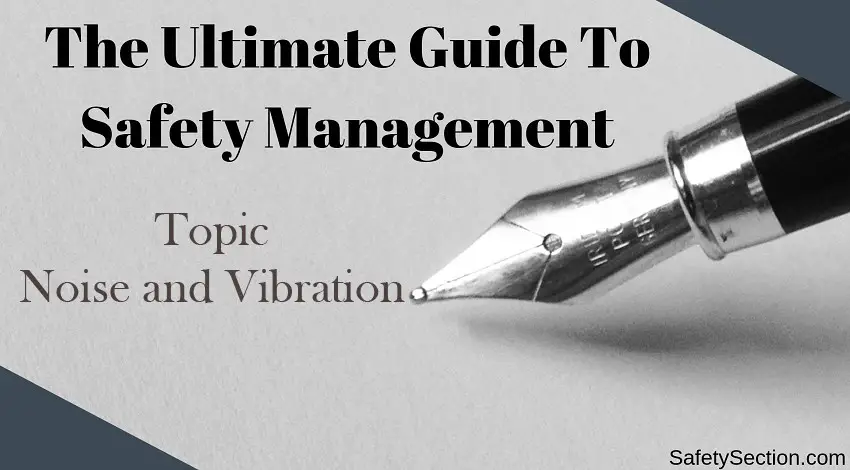Noise and vibration hazards are common yet often overlooked risks in workplaces, homes, and outdoor environments. Prolonged exposure can lead to serious health issues, including hearing loss, stress, and physical injuries. Understanding these hazards, their effects, and how to manage them is essential for ensuring safety and well-being.
What Are Noise and Vibration Hazards?
- Noise Hazards: High levels of sound that can damage hearing or interfere with communication and concentration. Examples include machinery, construction equipment, and loud music.
- Vibration Hazards: Mechanical oscillations that can cause physical harm, particularly from tools, vehicles, or industrial equipment. They are classified into two types:
- Hand-Arm Vibration (HAV): From tools like jackhammers or chainsaws, affecting hands and arms.
- Whole-Body Vibration (WBV): From vehicles or heavy machinery, affecting the entire body.

Health Effects of Noise and Vibration Exposure
Noise Hazards
- Hearing Loss
- Prolonged exposure to sounds above 85 decibels (dB) can lead to permanent hearing damage.
- Tinnitus
- Persistent ringing or buzzing in the ears caused by noise exposure.
- Stress and Fatigue
- Constant noise can increase stress levels, disrupt sleep, and impair concentration.
- Communication Barriers
- High noise levels hinder verbal communication, increasing the risk of accidents.
Vibration Hazards
- Hand-Arm Vibration Syndrome (HAVS)
- Symptoms include numbness, tingling, and reduced grip strength, potentially leading to permanent damage.
- Musculoskeletal Disorders
- Prolonged exposure to vibrations can cause back pain, joint issues, and fatigue.
- Circulatory Problems
- Vibration exposure can reduce blood flow, leading to conditions like vibration white finger (VWF).
- Organ Damage
- Whole-body vibration over time can harm internal organs and disrupt bodily functions.
Sources of Noise and Vibration Hazards
- Industrial Settings: Heavy machinery, compressors, generators.
- Construction Sites: Power tools, jackhammers, excavators.
- Transportation: Trains, trucks, and aircraft.
- Household Sources: Lawn equipment, appliances, and music systems.
- Recreational Activities: Concerts, shooting ranges, or motorized sports.
How to Identify Noise and Vibration Hazards
- Noise Assessment
- Use a sound level meter to measure decibel levels.
- Identify areas or tasks with prolonged high noise exposure.
- Vibration Monitoring
- Measure vibration levels using specialized tools like accelerometers.
- Observe workers or individuals for signs of discomfort or strain.
- Health Symptoms
- Look for complaints of hearing issues, hand numbness, or musculoskeletal pain.
Managing Noise and Vibration Hazards
Noise and vibration hazards are common in various industries, from construction to manufacturing, as well as in everyday environments. Prolonged exposure to these hazards can lead to significant health problems and safety risks. Effectively managing these hazards is essential to protecting workers and ensuring regulatory compliance.
1. Hazard Assessment
- Noise: Use sound level meters or dosimeters to measure noise levels across the workspace. Identify areas exceeding 85 dB.
- Vibration: Use accelerometers to measure the intensity and frequency of vibrations from tools or equipment.
2. Engineering Controls
- Install sound barriers, noise-absorbing materials, or vibration isolation mounts.
- Replace outdated equipment with quieter and less vibration-intensive models.
- Apply dampening solutions such as mats, pads, or dampers.
3. Administrative Controls
- Rotate workers to minimize exposure duration.
- Schedule noisy or vibrating tasks during periods with fewer people present.
- Implement mandatory rest periods to reduce fatigue.
4. Personal Protective Equipment (PPE)
- For Noise: Provide earplugs, earmuffs, or noise-canceling headsets.
- For Vibration: Use anti-vibration gloves, padded seats, or vibration-dampening mats.
5. Training and Awareness
- Educate employees about the risks of noise and vibration exposure.
- Train workers on proper use and maintenance of PPE and equipment.
- Conduct regular safety meetings to reinforce best practices.
6. Maintenance and Monitoring
- Regularly service equipment to ensure optimal performance and reduced emissions.
- Conduct periodic checks to monitor noise and vibration levels, ensuring they remain within acceptable limits.
Best Hearing Protection in the Workplace [Top Picks in 2023]
Personal Protective Equipment for Noise and Vibration
Exposure to excessive noise and vibration can lead to serious health issues, including hearing loss, hand-arm vibration syndrome (HAVS), and musculoskeletal disorders. Personal Protective Equipment (PPE) is an essential line of defense to safeguard individuals from these hazards. This guide explores the types of PPE available, their benefits, and how to select the right equipment for specific environments.
Why Is PPE Important for Noise and Vibration?
PPE helps minimize the impact of noise and vibration on the body, reducing the risk of long-term health problems. It serves as a supplementary control measure when engineering and administrative solutions cannot completely eliminate exposure.
Health Risks of Noise
- Hearing loss and tinnitus.
- Increased stress levels.
- Reduced communication and situational awareness.
Health Risks of Vibration
- Hand-Arm Vibration Syndrome (HAVS).
- Vibration White Finger (VWF).
- Musculoskeletal disorders and circulatory issues.
PPE for Noise Hazards

1. Earplugs
The best earplugs for noise hazards depend on your specific environment and needs. Here are some top recommendations:
Foam Earplugs
- Examples: 3M E-A-Rsoft Yellow Neons, Howard Leight Laser Lite.
- Best For: High noise environments like construction or industrial sites.
- Benefits: Affordable, disposable, and provide excellent noise reduction (typically 30+ NRR).
Silicone or Reusable Earplugs
- Examples: Mack’s Ultra Soft Silicone Earplugs, Etymotic Research ER20XS.
- Best For: Long-term use in moderate noise environments like offices or workshops.
- Benefits: Comfortable, washable, and cost-effective over time.
High-Fidelity Earplugs
- Examples: Eargasm High Fidelity Earplugs, Vibes Hi-Fidelity Earplugs.
- Best For: Musicians, concertgoers, or workers needing clear sound without distortion.
- Benefits: Reduce noise evenly while preserving sound quality.
Custom-Molded Earplugs
- Examples: Decibullz Custom Molded Earplugs, ACS Pro Series.
- Best For: Professionals in consistent high-noise environments.
- Benefits: Tailored fit, reusable, and excellent protection.
Electronic Earplugs
- Examples: Peltor TEP-200 Tactical Earplugs, Walker’s Silencer.
- Best For: Workers or hunters needing situational awareness.
- Benefits: Actively reduce harmful noise while amplifying safe sounds.
When choosing earplugs, look for a Noise Reduction Rating (NRR) appropriate for your environment, ensuring they meet your safety standards and comfort preferences.
2. Earmuffs
3. Noise-Canceling Headsets
Noise-canceling headsets are an excellent choice for environments where reducing noise is essential without isolating you from critical sounds or communication. Here are some of the best options, categorized by use case:
PPE for Vibration Hazards
1. Anti-Vibration Gloves
2. Padded Seats or Mats
- Description: Cushioned seating or floor mats designed to reduce whole-body vibration.
- Use: Suitable for operators of heavy machinery or vehicles.
- Benefits: Minimizes strain on the spine and internal organs.
3. Vibration-Dampening Tool Attachments
- Description: Attachments or handles added to tools to absorb vibrations.
- Use: Best for high-vibration tools in industrial settings.
- Benefits: Enhances worker safety without altering tool efficiency.
Selecting the Right PPE
- Assess the Hazard
- Use sound level meters to measure noise levels and accelerometers for vibration intensity.
- Identify the sources and duration of exposure.
- Consider Comfort and Fit
- Ensure the PPE fits properly for optimal protection.
- Test for comfort, especially for prolonged use.
- Check Protection Levels
- Verify that earplugs or earmuffs meet standards for noise reduction, such as Noise Reduction Rating (NRR).
- Ensure anti-vibration gloves comply with ISO 10819 standards.
- Durability and Maintenance
- Choose durable PPE that can withstand regular use.
- Follow cleaning and maintenance instructions to maintain effectiveness.
Combining PPE with Other Controls
PPE should complement other noise and vibration control measures:
- Engineering Controls: Install barriers, dampeners, or soundproofing materials.
- Administrative Controls: Limit exposure time and rotate tasks among workers.
- Training: Educate workers on the proper use and care of PPE.
Personal Protective Equipment is an essential part of managing noise and vibration hazards, protecting individuals from potentially debilitating health effects. By choosing the right PPE and combining it with other control measures, workplaces can ensure a safer and more productive environment for all.
Regulations and Standards
- Occupational Safety and Health Administration (OSHA)
- Sets permissible noise exposure levels and requires hearing protection for workplaces exceeding 85 dB.
- ISO Standards
- ISO 5349 for hand-arm vibration and ISO 2631 for whole-body vibration provide guidelines for safe exposure limits.
- Local Legislation
- Many countries enforce specific rules for controlling noise and vibration in industrial and public spaces.
Why Managing These Hazards Matters
- Health Protection: Reduces the risk of long-term health problems.
- Productivity: Prevents worker fatigue and enhances focus.
- Legal Compliance: Avoids fines and legal issues from failing to meet safety regulations.
- Quality of Life: Minimizes discomfort and stress for individuals in noisy or vibrating environments.
Frequently Asked Questions
What are the major hazards due to noise and vibration?
The major hazards of noise and vibration include hearing loss, tinnitus, stress, musculoskeletal disorders, hand-arm vibration syndrome (HAVS), circulatory issues, and reduced communication or safety in workplaces.
How do you control vibration hazards?
Vibration hazards can be controlled by using anti-vibration tools, installing dampers or isolation mounts, rotating tasks to limit exposure, maintaining equipment, and providing protective gear like anti-vibration gloves.
How do you reduce vibration and noise?
Reduce vibration and noise by using dampers, isolation mounts, soundproofing materials, maintaining equipment, limiting exposure time, and employing quieter or low-vibration tools and machinery.
Conclusion
Effective management of noise and vibration hazards involves a combination of hazard assessment, engineering solutions, administrative practices, and personal protective equipment. By prioritizing these measures, workplaces can ensure a safer environment, enhance productivity, and protect workers from long-term health impacts. Managing these hazards is not just a regulatory obligation—it’s a commitment to the health and well-being of everyone involved.
